IN THIS ISSUE
- Conserving Lee County wetlands
- Thumbs up for downy woodpeckers
- State's newest orchid found at Sansavilla
- Berry airlift: Eagle (briefly) tackles big limb
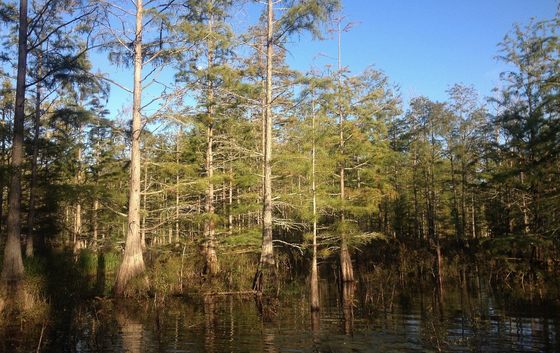 Cypress in Neyami Savanna (Lisa Kruse/DNR)
For a small community in rural Lee County, Neyami seems to have an angle on interesting. One story is that the name Neyami – it's pronounced like Miami but with an “N” – refers to being about midway between New York City and Miami. Another footnote is that country star Luke Bryan, raised in nearby Leesburg, once played in the band Neyami Road.
But these days Neyami is attracting interest for another reason: Landowners and government agencies have teamed up here to preserve rare wetlands and their rarest plant species, Canby’s dropwort.
The focal site is Neyami Savanna, a complex of boggy grasslands with open canopies of pine and cypress and one of Georgia’s largest populations of endangered Canby’s dropwort. Oxypolis canbyi is a slender member of the carrot family that dots the savanna with clusters of tiny white flowers in late summer.
The loss of cypress savanna wetlands has decimated the species. Recovering Canby’s dropwort to the point it no longer needs federal listing is a priority for the U.S. Fish and Wildlife Service and DNR. Yet Neyami Savanna is also key to other rare wildlife. It provides foraging habitat for federally threatened wood storks and freshwater to five federally listed or at-risk mussel species within 3 miles downstream.
 Canby's dropwort flowering (Jim Allison)
The U.S. Department of
Agriculture recently awarded $1.19 million to restore and permanently
protect 850 acres of the wetlands and their Canby’s dropwort
populations. The funding from the Natural Resource Conservation Service’s Wetland Reserve
Enhancement Partnership will be used for conservation easements and
ecological and hydrological restoration. Partners include local
landowners, DNR, the Georgia Department of Transportation, the Fish and
Wildlife Service and the Georgia Plant Conservation Alliance.
Managing these wetlands as a whole is vital to long-term ecological restoration, according to DNR Nongame Conservation Section botanist Lisa Kruse.
“Our neighbors are critical to the success of any management here,” Kruse said.
Read more about the Neyami Savanna project.
Back to top.
 Downy woodpecker (Josiah Lavender)
By TERRY W. JOHNSON
Georgians feed birds more in winter than during any other season, and with a wider lineup of foods.
Ranging from seeds to suet and even doughnuts, this smorgasbord attracts a variety of birds. But none may be more welcomed than the downy woodpecker.
About the size of a house sparrow, the downy is North America’s smallest woodpecker. It’s also one of the busiest. John James Audubon wrote that downy is "not surpassed by any of its tribe in hardiness, industry, or vivacity. …”
Read the rest of Terry’s column for insights into downy woodpeckers, including favored foods and tips for telling them apart from hairy woodpeckers.
Terry W.
Johnson is a retired DNR nongame program manager and executive director of
TERN, Nongame
Conservation’s friends group. Read more in the Out My Backdoor library,
on Terry's Backyard Wildlife
Connection blog and in his book “A Journey of
Discovery: Monroe County Outdoors.”
Back to top.
 Jug orchids at Sansavilla WMA (Jacob Thompson/DNR)
The acquisition of the last part of Sansavilla Wildlife Management Area was announced in mid-October. A week later, a Nongame Conservation Section employee discovered another example of why this 19,500-acre slice of the Altamaha River watershed is such a treasure.
Ethan Hughes was doing field surveys for habitat mapping on the Wayne County WMA when he discovered jug orchid in a forested seep. That’s the first time the orchid has been recorded in Georgia.
Jug orchid, Platythelys querceticola, grows no taller than 6 inches (it’s also called low ground orchid) and is an inconspicuous inhabitant of swamps and floodplains. More common in Central and South America, the plant’s range extends into Florida, Mississippi and Louisiana. The species rates as rare in the latter two states.
Hughes’ find adds to Sansavilla’s growing lineup of plants, animals and habitats considered conservation priorities. Remote sensing and field work done to develop fine-scale habitat maps on public lands along the lower Altamaha also recently turned up high-quality calcareous wet oak flats and small-stream floodplain forests, two other unique habitats, wrote Nongame Conservation biologist Jacob Thompson.
Those details will factor into management plans for the WMA and the corridor.
Back to top.
Seasonal survey flights for North Atlantic right whales have begun off the north Florida and Georgia coast. According to a new study, the population of these endangered whales that calve in the Southeast has declined in 2010 because of decreased calving and high rates of fishing rope entanglements and ship strikes, adding to concerns raised by the deaths of 17 right whales in the U.S. and Canada in 2017. (Boaters cautioned: Be on the lookout for right whales.)
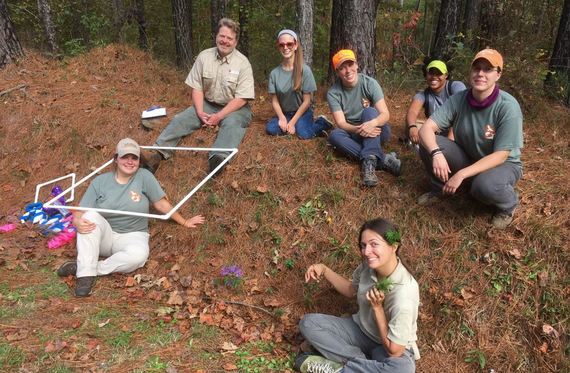 Georgia aster monitoring crew (Tom Patrick/DNR)
Long-term monitoring of Georgia aster populations is required by a 2014 Candidate Conservation Agreement
aimed at keeping the rare wildflower off the endangered species list.
DNR’s Dr. Mincy Moffett Jr., Tom Patrick and Sabrina Sewell have
coordinated monitoring, including giving demonstrations to partners and establishing and collecting data at sites ranging from Oaky
Woods Wildlife Management Area near Perry to Red Top Mountain State
Park north of Marietta.
What to get the amphibian-lover in your life? Stuff their stocking with "Calls of the wild: vocalizations of Georgia's frogs," a DNR CD featuring the calls and life histories of frog and toad species found in Georgia. How to order.
“The journey of a semipalmated sandpiper” is a new story map that follows the Arctic-to-Brazil-and-back migration of a tagged sandpiper. The multimedia presentation by the Western Hemisphere Shorebird Reserve Network and Manomet includes former DNR nongame Program Manager Brad Winn, now at Manomet.
Bullard Creek Wildlife Management Area has grown by 491 acres, thanks to the addition of Georgia DOT’s Bell Telephone Tract. The 14,000-acre WMA near Hazelhurst is popular among hunters, horseback riders and wildlife viewers.
Back to top.
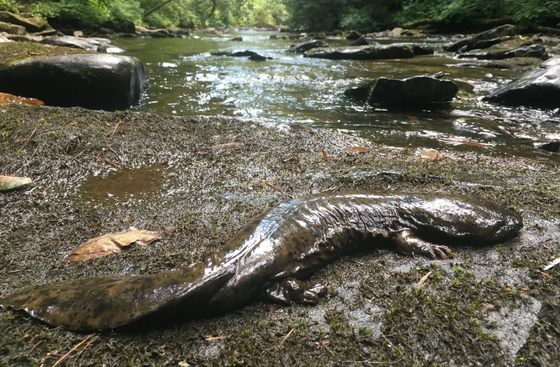 Eastern hellbender (Thomas Floyd/DNR)
Wanted: Projects that need a hand helping Georgians enjoy and better understand animals, plants and habitats emphasized in the State Wildlife Action Plan. With support from the Georgia Natural Resources Foundation, DNR Nongame Conservation has revived the competitive small-grants program to develop wildlife viewing opportunities statewide that raise awareness of key species and habitats.
How is translocation boosting the numbers and odds of endangered red-cockaded woodpeckers? Find out in this U.S. Fish and Wildlife Service blog post and video. (For a Georgia example, see “Rare Birds Back at River Creek,” Nov. 3.)
Georgia’s Give Wildlife a Chance Poster Contest is turning to the dark side. The theme of the 28th annual competition for grades K-5 is “Nature at night,” turning attention to the adaptive behaviors of wildlife and interactions with plants.
COMING UP
Dec. 8 – Amphibian Foundation open house, 6-10 p.m., Blue Heron Nature Preserve, Atlanta
Jan. 20 – Coastal Wildscapes Open the Garden Gate annual symposium, Richmond Hill City Center
Jan. 26-27 – Weekend for Wildlife, annual DNR fundraiser for nongame wildlife, Sea Island
Jan. 27 – Red Hills Fire Festival, Tall Timbers, Tallahassee, Fla.
WHAT YOU MISSED ...
in the last Georgia Wild.
- Rapping wildlife tags
- Rare birds back at River Creek
- Why add nest boxes before winter
Back to top.
(+ audio) "Georgia piecing together network of protected lands" along Altamaha, WABE-FM (90.1, Atlanta)
"Right whales migrating to S.C. coast in 'dire straits,'" The (Charleston) Post and Courier. Related: "North Atlantic’s greatest survivors hunted once more," The Guardian; "Shifting presence of right whales tracked with passive acoustics," NOAA Fisheries
"Red-cockaded woodpeckers returned to Thomasville-area WMA," The Albany Herald (paywall). Also: All on Georgia/Chattooga County
"Georgia coast globally important for shorebirds," Savannah Morning News. Also: U.S. News & World Report
"Rare fish only found in area may receive federal protection," Times Free Press (Chattanooga, Tenn.)
"Nature Conservancy celebrates Altama Plantation WMA," The Brunswick News
"Georgia’s fisheries chief winds up long career," The Augusta Chronicle
"Cherokee County educator named Conservation Teacher of Year," Woodstock Patch
"Wildlife viewing grants offered again, projects sought," The Covington News. Also: Athens Banner-Herald
"In search of scorpionflies in rural Georgia," Savannah Morning News
"Fungus could wipe out Alabama's largest bat colony," Alabama Public Radio
"Green sea turtle nest numbers hit record in Florida," Florida Fish and Wildlife Conservation Commission
"Estimating freshwater turtle mortality rates and population declines following hook ingestion," Conservation Biology
"Investing in conservation pays off," UGA Research, citing study in nature
"Return of the ’ologies: Natural history makes comeback on campus," Undark
"Orchid found in northern Florida declared endangered," WJCT Public Broadcasting (Jacksonville, Fla.)
"Augusta native retires as coastal resources chief," The Augusta Chronicle
"In toilets, streets: Snakes of Bangkok move in," The New York Times
"Land trust, partners focus on creating Ocala to Osceola wildlife corridor," The Gainesville (Fla.) Sun
Back to top.
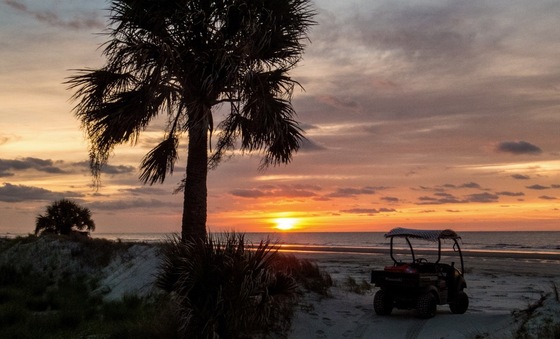 Sunrise on Ossabaw's north beach (Kyle Coleman/DNR)
VIDEO AND AUDIO
"Day in the life of a sea turtle tech on Ossabaw," Kyle Coleman, DNR
"Bald eagle released at Grassy Pond," interview with Nongame Program Manager Dr. Bob Sargent, The Valdosta Daily Times (news article)
"Red-cockaded woodpecker translocation," U.S. Fish and Wildlife Service
(audio) "Why bird poop is white," BirdNote. Also: "Why birds' feet don't freeze"
"The most amazing thing about trees," Veritasium
"Are drones the key to understanding polar bears?" The New York Times and Intel
Back to top.
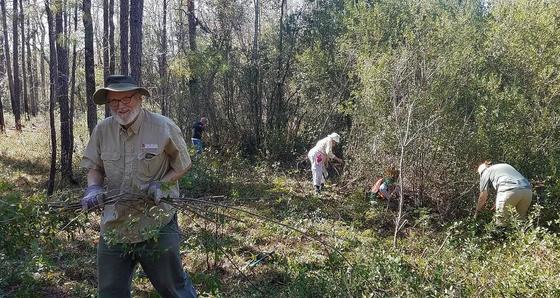 Canoochee Bogs work in progress (Lisa Kruse/DNR)
Canoochee
Bogs got an updo last month. A Georgia Plant Conservation Alliance workday
sporting 26 people from eight organizations cut truckloads of shrubs to open
key areas to prescribed fire and help restore the privately owned pitcherplant
bogs in southeast Georgia. The work came with surprises: locations of state-protected flame flower
and yellow pitcherplant, species botanists didn’t
know were there. Volunteers also cleared around orange-fringed orchid. The
changes will
allow prescribed fire to burn into the bogs and increase habitat for rare
plants.
Coastal Plain herbaceous bogs
are small but rare jewels, a priority habitat for rare-plant
conservation. They face threats such as hydrologic disturbance, development and fire
suppression. GPCA partners help restore, monitor and maintain
the bogs, and safeguard many southeastern Coastal Plain
pitcherplant and orchid species.
Masthead: 2017's sole supermoon, over northeast
Georgia (Josiah Lavender)
Back to top.
|